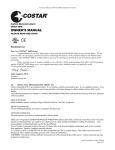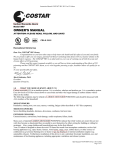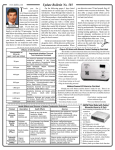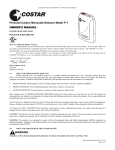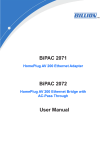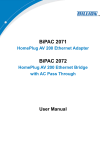Download Quantum Guardian QG100 Owner`s manual
Transcript
OWNER’S MANUAL Model QG100 Carbon Monoxide Alarm ATTENTION: PLEASE READ, FOLLOW AND SAVE! Dear New Quantum Guardian QG100 Owner, Congratulations as you have taken steps to help insure the health and life safety of you and your family. We are proud to offer you our unique, patented CO Sensor technology that detects CO selectively and has been tested False Alarm Free to common household vapors by Lawrence Berkley National laboratories. Report BNL 40556. The Quantum Guardian QG100 provides protection from acute CO poisoning. Please read this owner's manual carefully so you will have a better understanding of the effects of CO poisoning and the Quantum Guardian QG100 Alarm, as we work together pursuing a safer, healthier indoor air quality for us all. To your good health and safety, Mark Goldstein, Ph.D. President Quantum Group Inc. ! WARNING: Failure to replace this product by the “REPLACE BY DATE” printed on the alarm cover may result in death by Carbon Monoxide poisoning. Replace By Date is six (6) years from date of manufacture. 1.0 GENERAL DESCRIPTION This CO alarm is intended for protection from carbon monoxide in ordinary indoor residential areas, in recreational vehicles (RV) and in unconditioned spaces such as cabins, garages, basements, attics and commercial applications. It is not intended for use in Marine or industrial applications . Please note that product testing requirements for ”Unconditioned Spaces” are more severe than for residential “Conditioned Spaces”. 2.0 PRODUCT DATA Sensitivity Setting: Unit will alarm at 150 ppm CO within 50 minutes. Power: 9 volt alkaline battery Duracell MN 1604, Energizer 522 Current Draw: Standby 15 micro Amp. Alarm 30 milli Amp. Operating Temperature: Tested to -40° C – 66° C (-40° F - 150° F) Operating Humidity: 10-95% RH Horn (Sounder) Loudness: 85 db @ 10 ft (3.3 meters) 3.0 APPROVALS Listed by Underwriters Laboratories Inc. to UL standard 2034 4.0 WHAT YOU SHOULD KNOW ABOUT CO Carbon monoxide (CO) is an insidious poison. It is a colorless, odorless and tasteless gas. It is a cumulative poison. Even low levels of CO have been shown to cause brain and other vital organ damage in unborn infants with no effect on the mother. The following symptoms are related to CARBON MONOXIDE POISONING and should be discussed with ALL members of the household: MILD EXPOSURE Slight headache, nausea, vomiting, fatigue (often described as "flu–like" symptoms) MEDIUM EXPOSURE Severe throbbing headache, drowsiness, confusion, fast heart rate EXTREME EXPOSURE Unconsciousness, convulsions, cardio respiratory failure, death Many cases of reported CARBON MONOXIDE POISONING indicate that while victims are aware they are not well, they become so disoriented they are unable to save themselves by either exiting the building or calling for assistance. Also, young children and household pets may be the first affected. Your CO alarm is designed to detect the toxic CO fumes that result from incomplete combustion, such as those emitted from appliances, furnaces, fireplaces and auto exhaust. A CO Alarm is NOT A SUBSTITUTE for other combustible gas, fire or smoke alarms. This carbon monoxide alarm is designed to detect carbon monoxide gas from ANY source of combustion. CAUTION: This alarm will only indicate the presence of carbon monoxide gas at the sensor. Carbon monoxide gas may be present in other areas. WARNING: This product is intended for use in ordinary indoor locations of family living units. It is not designed to comply with Occupational Safety and Health Administration (OSHA) commercial or industrial standards. Individuals with medical problems may consider using warning devices that provide audible and visual signals for carbon monoxide concentrations under 30 ppm. 5.0 WHAT YOU SHOULD DO IF THE ALARM SOUNDS ! WARNING: Activation of this device indicates the presence of carbon monoxide (CO) which can kill you. If alarm sounds: 1 Operate reset/silence button; 2 Call your emergency services (____ - ______) [fire department or 911]; 3 Immediately move to fresh air –outdoors or by an open door/window. Do a head count to check that all persons are accounted for. Do not reenter the premises nor move away from the open door/window until the emergency services responders have arrived, the premises have been aired out, and your alarm remains in its normal condition. 4 After following steps 1-3, if your alarm reactivates within a 24 hour period, repeat steps 1-3 and call a qualified technician (____ ______) to investigate for sources of CO from fuel burning equipment and appliances, and inspect for proper operation of this equipment. If problems are identified during this inspection, have the equipment serviced immediately. Note any combustion equipment not inspected by the technician and consult the manufacturers' instructions or contact the manufacturers directly for more information about CO safety and this equipment. Make sure that motor vehicles are not and have not been operating in an attached garage or adjacent to the residence. 5.1 Never disconnect the battery to silence an alarm. The alarm will automatically sense when the level of CO in the air falls below the danger level. You should stay outside the residence, RV or unconditioned area in fresh air until the alarm is silenced. When the alarm sounds, do not stand too close to the alarm. The sound produced by the alarm is loud because it is designed to awaken a person in an emergency. Prolonged exposure to the alarm at a close distance may be harmful to your hearing. 6.0 DEVELOPING YOUR OWN CO SAFETY PLAN This CO alarm can quickly alert you to the presence of CO — it cannot prevent toxic CO emissions. Please note that there are hazards against which CO detection may not be effective, such as gas leaks or explosions. The ultimate responsibility for protection against toxic CO fumes rests solely on you. Installing CO detectors is just the first step in protecting your family from toxic CO poisoning. We also suggest that you create an effective, comprehensive safety program as outlined below. 6.1 Install CO detectors properly following the instructions in this manual. 6.2 Develop a family escape plan and practice it with your entire family, especially small children. – Draw a floor plan of your home and find two ways to exit from each room. There should be one way to get out of each bedroom without opening the door. – Teach children what the CO alarm signal means and how they must exit the residence by themselves if necessary. – Decide on a meeting place a safe distance from your house and make sure all children understand where they should go and wait if there is a dangerous CO condition. – Conduct CO safety drills at least every 6 months to make sure that everyone, even small children, know what to do in order to escape safely. – Know where to go to call the Fire Department from outside your residence, recreational vehicle or unconditioned area. 7.0 IMPORTANT: WHAT YOUR CO ALARM CAN AND CANNOT DO This CO alarm is designed for use within a single residential living unit, recreational vehicle or unconditioned space. It is designed to detect carbon monoxide (CO) entering its sensing chamber. It does not sense combustible gas (such as natural gas, propane or (butane), heat, smoke or flames When properly located, installed, and maintained, this CO alarm is designed to provide early warning of developing poisonous CO conditions at a reasonable cost. This alarm monitors the air, and when it senses CO, it activates its built-in alarm. It can provide precious time for you and your family to escape from your residence before CO can seriously injure or kill. However, such an early warning is possible only if the alarm is located, installed, and maintained as specified in the Owner's Manual 8.0 INSTALLING THE QUANTUM GUARDIAN QG100 One of the most important considerations in any CO alarm system is the location of the alarms. Statistics of the National Fire Protection Association (NFPA) show that most of the fatal CO occurrences happen at night while people are sleeping. Early warning of CO is best achieved by the correct installation of CO alarms. RESIDENTIAL INSTALLATION RECOMMENDATIONS If bedroom doors are usually closed at night, alarms should be placed in each bedroom as well as in the common hallway between them. CO alarms may not sense CO on a different level of a residence or building. For example, a second floor alarm may not sense a CO leak on the first floor or in the basement. Therefore, alarms should be placed on every level of a residence or building. If the alarm is located outside of a bedroom, it may not wake up a sound sleeper, especially if the bedroom door is closed or only partly open. If the alarm is located on a different level of the residence than the bedrooms, it is even less likely to wake up people sleeping in the bedroom. Installing CO alarms may qualify you for lower homeowner's insurance rates, but CO alarms are not a substitute for insurance. Homeowners and renters should continue to insure their lives and property. Attic Bedroom Bedroom Den Living Room Basement Master Bedroom Bedroom Kitchen Utility Room Garage = Carbon Monoxide alarm location for multi-level residence Figure 1: Recommended CO alarm protection for multi-level residence. Please note that the Quantum Guardian model QG100 is the only retail alarm approved for use in “Unconditioned Space” such as garages, basements and attics. Kitchen Dining Room Bedroom RECREATIONAL VEHICLE INSTALLATION RECOMMENDATIONS Family Room Living Room Bedroom = Carbon Monoxide alarm location Bedroom Figure 2: Recommended CO alarm locations for a single floor residence Inside wall location Height 5' - 6' from floor Figure 3: Recommended CO alarm wallmounting location.Location is 5 to 6 feet from floor. = Carbon Monoxide alarm mounting location Figure 4: Recommended Mounting Locations for RVs 9.0 ALARM MOUNTING LOCATIONS This CO alarm may be mounted on the wall or ceiling. WALL LOCATION: Locate the top of the alarm at least 5-6’ feet from the floor. CEILING LOCATION: Alarm should be mounted as close as possible to the center of a hallway or room. If this is not possible, the edge of the alarm should be at least 4 inches from any wall 9.1 LOCATIONS TO AVOID: Nuisance alarms are caused by placing units where they will not operate properly. To avoid nuisance alarms, do not place units: – Within 5 feet (1.5m) of any cooking appliance or furnace. – Near an open window or door, because the fresh air entering the opening may delay CO from reaching the alarm. – In damp or very humid areas or next to bathrooms with showers. – In very cold or very hot environments or in unheated buildings or outdoor rooms where the temperature can go below or above the operating range of the alarm. – Good ventilation is recommended when household cleaning supplies or similar contaminant's are used. 9.2 CONDITIONS WHICH CAN RESULT IN TEMPORARY CO SITUATIONS: Excessive spillage or reverse venting of fuel burning appliances caused by outdoor ambient conditions, such as: 1 Wind direction and/or velocity, including high gusts of wind. Heavy air in the vent pipes (cold/humid air with extended periods between cycles). 2 Negative pressure differential resulting from the use of exhaust fans. 3 Simultaneous operation of several fuel burning appliances competing for limited internal air. 4 Vent pipe connections vibrating loose from clothes dryers, furnaces, or water heaters. 5 Obstructions in or unconventional vent pipe designs which can amplify the above situations. 6 Extended operation of unvented fuel burning devices (range, oven, fireplace, etc.) 7 Temperature inversions which can trap exhaust gasses near the ground. 10.0 INSTALLATION INSTRUCTIONS: READ CAREFULLY BEFORE INSTALLING ALARM CAUTION: THIS UNIT IS SEALED. THE COVER IS NOT REMOVABLE! 10.1 Select proper location (See section 8.0) 10.2 A mounting plate is provided on the back of the alarm. Remove the mounting plate from the back of the alarm by holding the mounting plate and twisting the alarm in the direction indicated by the "OFF" arrow on the alarm cover. INSTALL REMOVE 10.3 To insure aesthetic alignment of the alarm UP with the hallway or wall, the UP arrow on the mounting plate must be: A.) Parallel with the hallway walls when ceiling mounting B.) Vertical when wall mounting (See figure 3) 10.4 As described in Section 8 figures 1-4, attach the mounting plate on the wall or ceiling. Use the screws and anchors provided to secure the mounting plate. UP MOUNTING HOOKS (2) MOUNTING HOLES (2) 10.5 Activate the alarm, by removing and disposing of the “Warning” Pull Tab. as shown in Figure 5 on the following page. WARNING: BATTERY IS REQUIRED FOR ALARM OPERATION AND DETECTION OF CARBON MONOXIDE. IF NO BATTERY IS INSTALLED, THE BATTERY DOOR WILL NOT CLOSE EASILY AND THE UNIT WILL NOT ATTACH TO THE MOUNTING BRACKET. 10.6 Attach alarm to the mounting plate and twist in the “ON” direction shown on the cover. INSTALL REMOVE Figure 5: Alarm Activation Pull and remove tab to activate the alarm. 10.7 To make your carbon monoxide alarm tamper resistant, a locking pin has been provided in the bag with the screws and anchors. Using this pin will deter children and others from removing the alarm from the mounting plate. To use the pin insert it into the hole in the side of the alarm after the alarm has been installed on the mounting plate (See figure 6). Note the tamper resist pin will have to be removed in order to change the battery; TAMPER RESISTANT LOCKING PIN FIGURE 6 this can be done easily with a long nose pliers. Using the long nose pliers pull the pin out of the hole, it is now possible to remove the alarm from the mounting plate. 10.8 This box contains two self-adhesive labels. You should write the telephone numbers of the emergency service provider and a qualified technician in the space provided on the labels. Place one label next to the alarm, and the other label near a source of fresh air where you plan to gather after the alarm indicates the presence of carbon monoxide. 11.0 ALARM SIGNALS 11.1. NORMAL OPERATION: RED LED flashes once every 30 seconds, indicating that the alarm is powered 11.2. ALARM CONDITION: RED LED turns "on" for 2 seconds and "off" for 3 seconds with 4 short beeps for 1 second and 5 seconds of silence 11.3. FAULT CONDITION: RED LED flashes and beeps once every 30 seconds. Device is not working properly and should be replaced immediately. 11.4. LOW BATTERY: One chirp every 30 seconds. Replace battery when this signal occurs 12.0 MAINTENANCE CLEANING YOUR ALARM: 12.1. Keep your CO alarm clean using a damp cloth or vacumn. 12.2. To clean your alarm remove it from the mounting bracket as outlined in section 10.2 IF TAMPER RESISTANT PIN HAS BEEN USED, REFER TO STEP 10.7 UNDER INSTALLATION INSTRUCTIONS FOR REMOVAL INSTRUCTIONS. (See Figure 6) 12.3 You can clean the interior of your alarm by using your vacuum cleaner hose and vacuuming through the openings around the perimeter of the alarm. 12.4 The outside can be wiped with a cloth. 12.5 After cleaning, reinstall your alarm, as outlined in Section 10.6, and test your alarm by using the TEST button. 12.6 Test your detectors weekly and repair or replace them when they no longer function. As with any electronic product, alarms have a limited life and alarms that do not work cannot protect you. (See section 14.0) WARNING: Do not use any household cleaning agents, paints, varnishes or any other chemical on your QG100 alarm. NOTE: REGULAR TESTING IS RECOMMENDED. 13.0 BATTERY REPLACEMENT: IF TAMPER RESISTANT PIN HAS BEEN USED, REFER TO SECTION 10.7 UNDER INSTALLATION INSTRUCTIONS FOR REMOVAL INSTRUCTIONS. 13.1 To replace the battery remove the alarm from the mounting plate by rotating the alarm in the direction of the "OFF" arrow on the cover (See Section 10.2). Remove and reinstall the battery in the correct orientation as noted on the inside of the battery door. After re-installing the battery, place the alarm on the mounting plate. Twist + the alarm in the direction indicated by the "ON" arrow on the alarm cover (see Figure 7 Section 10.6) until it locks in place. The alarm will beep once indicating proper battery installation. 13.2 Test alarm immediately following installation and weekly for proper operation by pushing the test button until a short beep is heard (three seconds). Release the button. The alarm will then test itself for proper operation and the RED LED will flash 5 times. At completion of the self test, the alarm will sound 2 alarm patterns (4 Beeps, pause, 4 Beeps). The alarm then resumes normal operation 13.3 The Quantum Guardian Model QG100 CO Alarm uses one (1) 9 volt alkaline battery. A fresh battery should last for one year under normal operating conditions. 13.4 USE ONLY THE FOLLOWING 9 VOLT BATTERIES FOR CO ALARM REPLACEMENT. Alkaline type: DURACELL MN1604, ENERGIZER 522. These batteries are available at most local retail stores. ! WARNING: USE ONLY THE BATTERIES SPECIFIED. USE OF DIFFERENT BATTERIES MAY HAVE A DETRIMENTAL EFFECT ON THE CO ALARM. THE CONSTANT EXPOSURES TO HIGH OR LOW TEMPERATURES OR HIGH HUMIDITY MAY REDUCE BATTERY LIFE. CHECK THE BATTERY MANUFACTURERS SPECIFICATIONS FOR PROPER OPERATING CONDITIONS. Note: Most batteries are not rated below -20°C or above 52°C STORAGE, BEFORE EACH TRIP, AND AT LEAST ONCE PER WEEK DURING USE. 14.0 PERIODIC ALARM TESTING: Test the alarm for proper operation by pushing the test button until a short beep is heard (approximately three seconds). Release the button. The alarm will then test itself for proper operation and the RED LED light will flash 5 times. At completion of the self test, the alarm will sound 2 patterns. The alarm then resumes normal operation. 15.0 SERVICE AND WARRANTY If after reviewing this manual you feel that your CO Alarm is defective in any way, do not tamper with the unit. Call Quantum Group's customer service line at 1-800-432-5599 to receive a return merchandise authorization (RMA) number prior to returning product. Once an RMA number has been issued, return product along with a note describing the problem with postage prepaid to: WARNING RESIDENTIAL AND UNCONDITIONED AREA USE: TEST ALARM OPERATION AT LEAST ONCE PER WEEK DURING USE. WARNING RECREATIONAL VEHICLE USE: TEST ALARM OPERATION AFTER RECREATIONAL VEHICLE HAS BEEN IN 6827 Nancy Ridge Dr. San Diego, CA 92121-2233 Or call us toll free 1-800-432-5599 E-mail address: [email protected] LIMITED WARRANTY QUANTUM GUARDIAN Model QG100 from the date of manufacture. During the initial two (2) year period commencing with the The 6 year limited warranty has a 2 year date of manufacture, any repair or replacement replacement window at no cost with a new shall be made without charge. During the latalarm if it fails. After 2 years the price will be ter four (4) years of the warranty period, any prorated like tires on your car, which means you repair or replacement shall be made at a can buy a new alarm for 50% off of the retail price charge to the purchaser not to exceed the manif your product fails between 2 and 3 years. ufacturer's cost of repair or replacement. All Quantum Group Inc. offers you this limited replaced items become the property of warranty on your new carbon monoxide Quantum Group Inc. alarm, including all of its component parts. This limited warranty extends solely to the QUANTUM GROUP INC. MAKES NO original end-user purchaser of this product, OTHER WARRANTIES, EXPRESS OR provided your purchase was made from an IMPLIED, EXCEPT AS REQUIRED BY authorized vendor. Transfer or resale of this LAW, AND IN NO CASE FOR A DURAproduct will automatically terminate warranty TION LONGER THAN THAT OF THIS coverage. WRITTEN WARRANTY, EXCEPT AS Quantum Group Inc. warrants the enclosed REQUIRED BY LAW, INCLUDING, BUT carbon monoxide alarm to be free from NOT LIMITED TO, ANY WARRANTY OF defects in materials and workmanship under MERCHANTABILITY OR FITNESS FOR A authorized use and service, as specified in the PARTICULAR PURPOSE OR AGAINST owner's manual, for a period of six (6) years INFRINGEMENT, OR ANY EXPRESS OR IMPLIED WARRANTY ARISING OUT OF TRADE USAGE OR OUT OF A COURSE OF DEALING OR COURSE OF PERFORMANCE. Quantum Group Inc. has not authorized any other party to extend any other warranties in connection with the sale of the product, and will not accept responsibility for any statements, representations, or warranties made by any other person. This limited warranty does not cover: (1) 9 volt alkaline battery; (2) products which have been improperly installed, repaired, maintained, modified, or which have been subjected to misuse, abuse, accident, neglect, exposure to fire, water, or excessive changes in climate or temperature, or combined with nonQuantum Group Inc. - approved accessories; (2) physical damage caused from use other than normal and proper operation or handling, as specified in the owner's manual; (3) cosmetic damage; (4) products on which warranty stickers or product serial numbers have been removed, altered, or rendered illegible; (5) the cost of installation, removal or reinstallation. QUANTUM GROUP INC. SPECIFICALLY DISCLAIMS LIABILITY FOR ANY AND ALL DIRECT, INDIRECT, SPECIAL, GENERAL, INCIDENTAL, OR CONSEQUENTIAL DAMAGES, INCLUDING, BUT NOT LIMITED TO, LOSS OF PROFITS OR ANTICIPATED PROFITS ARISING OUT OF USE OF OR INABILITY TO USE THE PRODUCT. QGI P/N 099-0125-01 060519






















